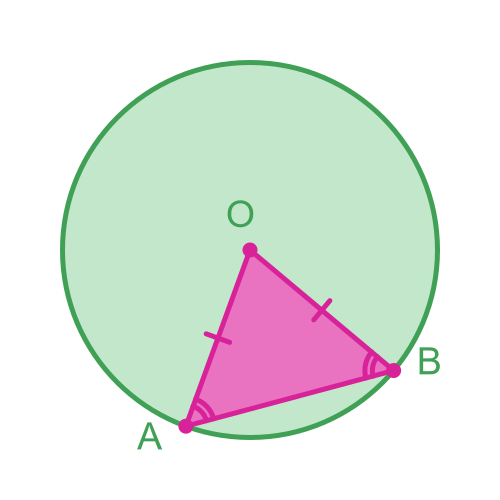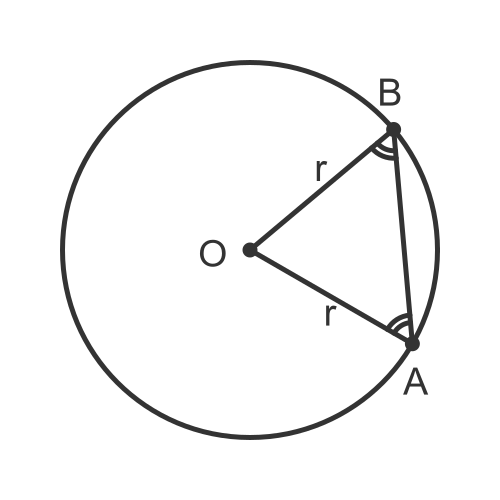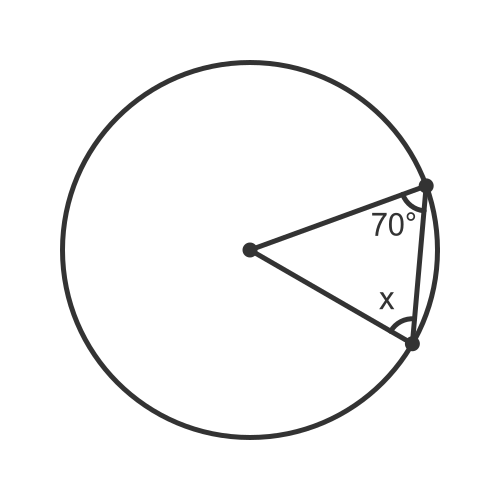Two radii form an isosceles triangle
Categories: gcse geometry
Level:

A triangle formed by two radii of a circle is always an isosceles triangle.
Here is a video on the topic:
Isosceles triangles
An isosceles triangle is a triangle that has two equal sides, like this:

The two angles at the base of an isosceles triangle are always equal.
Two radii of a circle
Two radii form the two equal sides of a triangle. The third side is formed by the chord that joins the ends of the two radii.

Since it is an isosceles triangle, it follows that the angles between the two radii and the chord that forms the third side of the triangle are also equal.
Proof
A circle is a set of points that are all the same distance from the centre.
A radius is a line drawn from the centre to any point on the circle.

Since every point on the circle is the same distance from the centre, every radius is the same length no matter where it is drawn.
Two sides of the triangle are radii of the circle and therefore have the same length. Any triangle with two equal sides is an isosceles triangle, by definition.
Since it is an isosceles triangle, the two angles A and B are also equal. This fact is sometimes useful, for example:

It might not be immediately obvious what the angle x is. But if we remember that the triangle is an isosceles triangle we can see very easily that x is equal to the other angle at the base, so it is 70 degrees.
Related articles
- Parts of a circle
- Perpendicular bisector of chord theorem
- Angle at the centre of a circle is twice the angle at the circumference
- Angle in a semicircle is 90°
- Angles in the same segment of a circle are equal
- Opposite angles in a cyclic quadrilateral add up to 180°
- Tangent and radius of a circle meet at 90°
- Two tangents from a point have equal length
- Alternate segment theorem
Join the GraphicMaths Newsletter
Sign up using this form to receive an email when new content is added to the graphpicmaths or pythoninformer websites:

Popular tags
adder adjacency matrix alu and gate angle answers area argand diagram binary maths cardioid cartesian equation chain rule chord circle cofactor combinations complex modulus complex numbers complex polygon complex power complex root cosh cosine cosine rule countable cpu cube decagon demorgans law derivative determinant diagonal directrix dodecagon e eigenvalue eigenvector ellipse equilateral triangle erf function euclid euler eulers formula eulers identity exercises exponent exponential exterior angle first principles flip-flop focus gabriels horn galileo gamma function gaussian distribution gradient graph hendecagon heptagon heron hexagon hilbert horizontal hyperbola hyperbolic function hyperbolic functions infinity integration integration by parts integration by substitution interior angle inverse function inverse hyperbolic function inverse matrix irrational irrational number irregular polygon isomorphic graph isosceles trapezium isosceles triangle kite koch curve l system lhopitals rule limit line integral locus logarithm maclaurin series major axis matrix matrix algebra mean minor axis n choose r nand gate net newton raphson method nonagon nor gate normal normal distribution not gate octagon or gate parabola parallelogram parametric equation pentagon perimeter permutation matrix permutations pi pi function polar coordinates polynomial power probability probability distribution product rule proof pythagoras proof quadrilateral questions quotient rule radians radius rectangle regular polygon rhombus root sech segment set set-reset flip-flop simpsons rule sine sine rule sinh slope sloping lines solving equations solving triangles square square root squeeze theorem standard curves standard deviation star polygon statistics straight line graphs surface of revolution symmetry tangent tanh transformation transformations translation trapezium triangle turtle graphics uncountable variance vertical volume volume of revolution xnor gate xor gate
